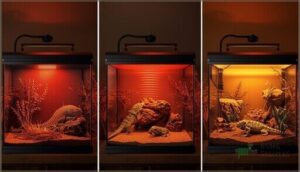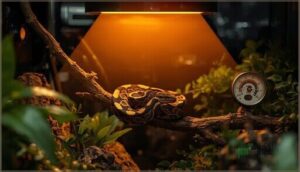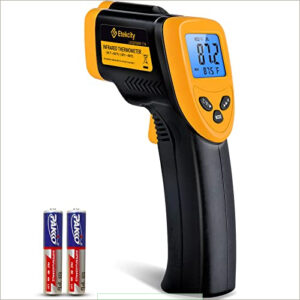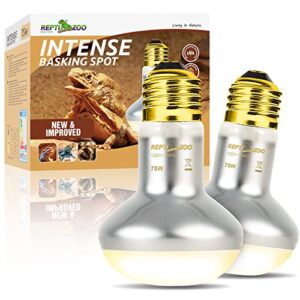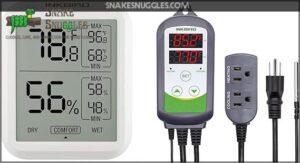This site is supported by our readers. We may earn a commission, at no cost to you, if you purchase through links.

Your ball python won’t tell you when it’s uncomfortable—it’ll just stop eating, struggle to digest, or become lethargic until the problem becomes serious. Temperature isn’t a minor detail in reptile care; it’s the foundation of every biological process your snake depends on, from breaking down food to fighting off infections.
Ball pythons evolved in the thermal gradients of West African savannas, where they move between warm and cool microhabitats throughout the day to regulate their body temperature. Without this ability to thermoregulate in captivity, your snake faces chronic stress that compounds over time.
Getting the temperatures right means understanding not just the numbers, but how to create a functional gradient that mimics natural conditions and maintains your python’s health for years to come.
Table Of Contents
- Key Takeaways
- Ideal Temperature Range for Ball Pythons
- Creating a Thermal Gradient in The Enclosure
- Heating Options for Ball Python Enclosures
- Monitoring and Adjusting Enclosure Temperatures
- Temperature Considerations for Ball Python Health
- Top 3 Temperature Control Products for Ball Pythons
- Frequently Asked Questions (FAQs)
- How often should I check the temperatures in my ball python’s enclosure?
- How can I safely lower enclosure temperature in summer?
- What are signs of temperature-related stress in ball pythons?
- Is fluctuating temperature throughout the day harmful?
- Can ball pythons tolerate brief power outages?
- How do seasonal changes affect temperature management?
- How does room temperature affect enclosure heating needs?
- What temperature is best for hatchlings versus adults?
- Should I adjust temperatures based on breeding season?
- Conclusion
Key Takeaways
- You’ll need to maintain a thermal gradient with warm-side temperatures between 88°F and 92°F and cool-side temperatures between 75°F and 80°F, creating a 10-15°F difference that allows your ball python to thermoregulate naturally by moving between zones.
- Your snake’s digestion, immune function, and shedding success depend entirely on consistent temperature control—temperatures below 75°F trigger hypothermia risks and respiratory infections, while temps above 95°F cause thermal burns and dehydration.
- Daily monitoring with digital probe thermometers and thermostat-controlled heat sources (ceramic emitters, heat lamps, or under-tank pads) prevents dangerous temperature fluctuations that can compromise your python’s health over time.
- Seasonal adjustments are essential since room temperature changes directly affect enclosure stability—you’ll need to increase thermostat settings by 2-4°F in winter and boost ventilation during summer while maintaining nighttime temperatures above 75°F year-round.
Ideal Temperature Range for Ball Pythons
Getting the temperature right in your ball python’s enclosure isn’t just a nice extra—it’s essential for their health, digestion, and overall well-being. Your snake needs different temperature zones within its habitat to thermoregulate properly, mimicking the natural conditions they’d experience in the wild.
Let’s break down the specific temperature ranges you’ll need to maintain for each area of the enclosure.
Warm Side and Cool Side Temperatures
Your ball python’s thermal gradient setup starts with warm side temperatures between 88°F and 92°F, while the cool side should stay at 75°F to 80°F. This temperature difference—usually 10°F to 15°F—allows your snake to thermoregulate naturally.
It’s important to note that Ball Pythons are known to be docile and friendly snakes. Warm hide temps above 93°F risk calorie degradation, and cool hide temps below 75°F impact digestion. Monitoring accuracy prevents these health impacts.
Basking Spot Temperature Recommendations
Once you’ve set your temperature gradient, focus on the basking area. The ideal temperature for a basking surface falls between 88°F and 92°F, never exceeding safety limits. Use an infrared thermometer for accurate measurement methods, since ambient warmth can mislead.
Maintaining this basking surface temperature aids digestion and overall health, helping your python thrive without risk of burns. A heat lamp or ceramic heater is often used to achieve the correct heat source for the basking area.
Nighttime Temperature Guidelines
At night, temperatures should drop slightly to support your ball python’s circadian rhythms and nocturnal activity.
Maintain a range of 70°F to 78°F—ideally above 75°F—to protect your snake’s immune system and digestion processes.
Use a thermostat with ceramic heat emitters to control nighttime thermoregulation without light. This approach mimics seasonal changes and promotes healthy ball python care throughout the year.
Creating a Thermal Gradient in The Enclosure
A thermal gradient isn’t just a nice feature in your ball python’s enclosure—it’s essential for their survival. In the wild, these snakes move between warm and cool areas throughout the day to regulate their body temperature, and you’ll need to recreate that same temperature range in captivity.
Let’s walk through how to set up this gradient correctly, starting with why it matters so much for your snake’s health.
Importance of Thermal Gradients
Think of a thermal gradient as your ball python’s personal thermostat—you can’t regulate their body temperature, so they must. Behavioral thermoregulation depends on temperature regulation across the enclosure, allowing your snake to shuttle between zones for digestive efficiency after meals and proper immune function.
A thermal gradient functions as your ball python’s personal thermostat, enabling them to regulate body temperature for digestion and immune health
Creating a thermal gradient of 10–15°F between warm and cool sides gives your python control over its own comfort and health.
Setting Up Warm and Cool Hides
Your ball python needs two distinct refuges positioned strategically across your enclosure’s temperature gradient. Place the warm hide directly under your heat source—targeting 86-90°F inside—using a thermostat to prevent overheating. Position the cool hide on the opposite end at 72-80°F.
Key considerations include:
- Hide material impacts heat retention and transfer efficiency
- Placement strategy determines gradient effectiveness
- Substrate impact affects temperature stability within hides
- Monitoring methods verify accurate hide temperatures continuously
Maintaining Consistent Ambient Temperatures
While thermal gradients matter, your enclosure’s overall ambient stability determines your snake’s long-term health. Maintain daytime ambient temperatures between 78–82°F using thermostat-controlled ceramic heat emitters or radiant panels, which provide consistent heat sources without disrupting day-night cycles.
Install digital thermometers on both sides to track ambient stability, adjusting thermostat calibration seasonally when household temperatures shift. Monitor ideal temperature levels daily—deviations beyond 2–3°F require immediate seasonal adjustments to prevent respiratory issues.
Heating Options for Ball Python Enclosures
Choosing the right heating equipment isn’t just about keeping your ball python warm—it’s about replicating the thermal environment they’d experience in their natural African habitat.
Each heating option has specific advantages depending on your enclosure setup, budget, and your snake’s behavioral needs.
Let’s examine the three primary heating methods that experienced keepers rely on to maintain proper temperature gradients.
Heat Lamps and Basking Bulbs
Heat lamps deliver basking warmth through infrared radiation, with incandescent heat bulbs and halogen bulbs distributing heat effectively across your enclosure. Maintain surface temperatures between 90–95°F, carefully adjusting bulb distance—usually around 12 inches—to avoid burns.
Thermostat control prevents dangerous spikes, while a 12-hour day-night cycle mimics natural conditions. Without proper regulation, health risks include thermal burns and heat stress.
Under-tank Heating Pads
Under-tank heat mats provide belly heat for your ball python, but you must pair them with a thermostat—unregulated pads reach dangerous 104–113°F, well above the safe 88–92°F target.
Cover one-third of your enclosure floor, position the thermostat probe between mat and tank, and add substrate depth to buffer heat.
Regular monitoring prevents burns while seasonal adjustments maintain proper gradient creation year-round.
Ceramic Heat Emitters and Their Use
Ceramic heat emitters produce 24-hour warmth without visible light, making them ideal for maintaining nighttime thermal gradients—but they require strict thermostat control to prevent burns.
Here’s how to use them safely:
- Wattage selection: Choose 100 W for wood enclosures, higher for glass tanks with greater heat loss
- Burn prevention: Install metal guards and position at least six inches above basking areas
- Performance limitations: Pair with basking lamps since ceramic emitters lack IR-A and IR-B for deep tissue heating
Monitoring and Adjusting Enclosure Temperatures
Maintaining the right temperatures in your ball python’s enclosure isn’t a set-it-and-forget-it task. You’ll need reliable tools to track what’s happening inside the habitat and the ability to make adjustments as conditions change throughout the year.
Let’s look at the essential equipment and strategies that’ll help you keep those temperatures dialed in perfectly.
Using Digital Probe Thermometers
You’ll find that digital probe thermometers deliver readings within ±1°C, far more accurate than analog dials that can miss your target by 5–7°F or more. Position probes directly at basking surfaces and inside hides—not buried in substrate—to capture the actual temperatures your snake experiences.
Use at least two probes to monitor both warm and cool sides, then cross-check with an infrared temp gun for complete environmental control.
Importance of Temperature Controllers
Accurate probes show you the numbers, but a thermostat control keeps those numbers locked in. Without one, your heating pad or ceramic emitter can climb past safe ranges, creating burn risk and unstable temperature gradients.
Modern features like dual-channel outlets and alarm systems protect against equipment failure while improving energy efficiency—so your snake stays safe and your setup runs smoothly around the clock.
Adjusting Heat Sources for Seasonal Changes
Room temperature swings between summer and winter months directly affect your enclosure’s thermal gradient. During colder periods, you’ll need to increase thermostat settings by 2–4°F and consider wattage adjustment to maintain proper heating.
Conversely, overheating prevention becomes critical in summer—reduce your heat source output, boost ventilation, and perform regular probe calibration. Nighttime reduction should still preserve temperatures above 70°F year-round.
Temperature Considerations for Ball Python Health
Temperature isn’t just about comfort for your ball python—it directly affects their ability to digest food, shed properly, and stay healthy overall. Getting the temperature wrong, whether too hot or too cold, can lead to serious health problems that are completely avoidable.
Let’s look at the specific temperature considerations that’ll keep your snake thriving through feeding, shedding, and everyday life.
Proper Temperatures for Digestion and Feeding
When your ball python is digesting a meal, maintaining the right thermal gradient becomes absolutely critical for metabolism and health. The warm side should stay between 88–92°F to guarantee efficient digestion, while the cool side can rest around 75–80°F, giving your snake behavioral control over its comfort.
Here’s what you need to know about feeding timing and temperature risks:
- Offer food only when temperatures are stable within the recommended warm-side range to encourage strong feeding responses.
- Never let nighttime drops fall below 75°F during digestion, as cooler conditions slow metabolism and may cause prey to decompose in the gut.
- Maintain a consistent warm area for at least 48 hours post-feeding to prevent stress-induced regurgitation from sudden thermal shifts.
- Allow your python to choose between hides on the thermal gradient—some individuals prefer the cool side even after eating, which is normal as long as minimum thresholds are met.
- Recognize that prolonged suboptimal temperatures (below 88°F on the warm side) can trigger bacterial growth in undigested prey, leading to regurgitation and potential infection.
Correct temperatures during and after feeding aren’t just about comfort—they’re essential to preventing gastrointestinal disturbances that compromise your snake’s health.
Managing Temperatures During Shedding
During the shedding period, your ball python’s thermal gradient should mirror normal ranges—88–92°F on the warm side and 75–80°F on the cool side. However, managing humidity during shedding becomes equally important. Nighttime temperatures should not drop below 75°F, as this can trigger shedding complications like retained eye caps. Practical management involves pairing the recommended 60–80% humidity with stable heat, as the shedding process relies on the interaction between humidity and consistent temperature to ensure the skin separates cleanly.
| Temperature Zone | Shedding Target |
|---|---|
| Warm Side | 88–92°F |
| Cool Side | 75–80°F |
| Nighttime Minimum | 75°F |
Risks of Temperature Extremes (High and Low)
When temperatures fall below 75°F, hypothermia risks emerge—your ball python’s metabolism slows, triggering lethargy and immune suppression that opens the door to respiratory infections and digestive issues.
Conversely, overheating dangers above 95°F compromise thermoregulation, causing thermal burns from direct contact with unregulated heat sources and dehydration that undermines reptile health.
Both extremes stress the immune system and can prove fatal.
Top 3 Temperature Control Products for Ball Pythons
Maintaining precise temperatures in your ball python’s enclosure requires reliable equipment that takes the guesswork out of heating. You’ll need tools to measure surface and air temperatures accurately, heat sources that deliver consistent warmth, and devices that automatically regulate heat output to prevent dangerous fluctuations.
The following three products represent essential components of a well-managed temperature control system for ball pythons.
1. Etekcity Laser Infrared Temperature Measurement Gun
When fine-tuning your ball pythons’ enclosure, you’ll want a tool that measures surface temperature instantly—that’s where the Etekcity Lasergrip 774 proves invaluable. This infrared thermometer reads temperatures from -58°F to 716°F with ±2% accuracy, letting you verify basking spots hit 88–92°F and cool areas stay around 76–80°F. Its 12:1 distance ratio means you’ll get precise readings from about 12 inches away.
Remember, it measures surfaces, not air, and highly reflective materials like glass can throw off readings—so check your heating setup directly on hides and substrate for reliable data.
Best For: Ball python keepers and reptile owners who need fast, accurate surface temperature readings to dial in basking spots, hides, and thermal gradients without guesswork.
- Instant readings in under 0.5 seconds with a 12:1 distance ratio let you scan multiple enclosure surfaces quickly and confirm your warm side hits 88–92°F and cool side stays around 76–80°F
- Wide temperature range (-58°F to 716°F) and ±2% accuracy work for checking everything from substrate and hide interiors to heat lamps and under-tank heaters
- Affordable and battery-efficient with auto shut-off after 15 seconds of inactivity, making it a practical everyday tool for routine enclosure checks
- Measures only surface temperature, not ambient air, so you’ll still need digital probe thermometers or thermostats for complete monitoring
- Reflective surfaces like glass, polished tile, or granite can give inaccurate readings unless you tape them with masking tape and wait 30 minutes for equilibration
- Fixed 0.95 emissivity means you can’t adjust for certain materials, and the laser pointer may be hard to see in bright sunlight or well-lit rooms
2. Repti Zoo Heat Lamp Bulb
You’ll often find the Repti Zoo Heat Lamp Bulb in 75W or 100W options delivers reliable heating for ball pythons without breaking your budget. These bulbs generate basking temperatures of 90–100°F when positioned 8–12 inches above substrate, fitting standard E26 fixtures in enclosures up to 40 gallons.
The 100W model boosts heating efficiency by roughly 35% over older designs while consuming moderate energy—expect about $3–4 monthly added to your electricity bill.
Always pair heat lamps with a thermostat to prevent dangerous temperature spikes that compromise your python’s health.
Best For: Budget-conscious reptile owners who need reliable supplemental heating for ball pythons and similar small reptiles in enclosures up to 40 gallons.
- The 100W model increases heating efficiency by 35% while maintaining moderate energy costs at around $3–4 per month for typical use
- Consistently achieves proper basking temperatures of 90–100°F when positioned correctly, with infrared options for nighttime heating that won’t disrupt sleep cycles
- Standard E26 base fits most common fixtures and combo packs include both day and night bulbs for complete thermal cycling
- Mixed durability reports with some bulbs burning out in just a few months despite the claimed 2,000–3,000 hour lifespan
- The bulb base can break off during replacement, making removal difficult and potentially damaging fixtures
- Requires careful monitoring and a separate thermostat purchase to prevent dangerous overheating in smaller or sealed enclosures
3. Inkbird Temperature Controller and Thermometer Bundle
An Inkbird bundle gives you precision control your ball python needs with dual-channel Wi-Fi thermostats, waterproof probes, and heating outlets rated for 1100 W. You’ll monitor temperature with ±1°C accuracy across the 32–113°F range—covering both warm and cool zones in one enclosure.
Safety features include high-temperature alarms and over-temp shutoffs that protect against dangerous spikes. The digital thermometer displays measured and target temps simultaneously, while smartphone alerts notify you of fluctuations even when you’re away, ensuring consistent heating through every season.
Best For: Ball python keepers who want precise, app-controlled temperature management across multiple zones with built-in safety alarms and remote monitoring.
- Dual-channel Wi-Fi control lets you manage both warm and cool zones independently from your phone, with real-time alerts if temperatures drift outside your set range
- High accuracy (±1°C) and adjustable differentials prevent dangerous overheating while keeping your snake’s gradient stable between 78–90°F
- Handles up to 1100 W per outlet, so you can safely run heat mats and ceramic emitters together without worrying about tripping relays
- The 32–113°F control range won’t work if you need to monitor extreme cold or very high basking temps outside typical ball python requirements
- Only works on 2.4 GHz Wi-Fi networks, which can be a hassle if your home router defaults to 5 GHz or dual-band auto-switching
- Probe cables are about 6.5 feet long—fine for most enclosures, but you might need extensions or creative routing in larger custom setups
Frequently Asked Questions (FAQs)
How often should I check the temperatures in my ball python’s enclosure?
You might think once-weekly checks are enough, but daily temperature checks using a digital thermometer are essential.
Continuous probe monitoring tracks your thermal gradient, while infrared spot-checking verifies ideal temperature levels during environmental changes.
How can I safely lower enclosure temperature in summer?
Lower your thermostat setpoint to 88–90°F, increase room ventilation with fans, and reduce nighttime heat sources when ambient temperatures exceed 75°F.
Blackout blinds prevent summer overheating by blocking solar gain into your enclosure.
What are signs of temperature-related stress in ball pythons?
Like a canary in a coal mine, your ball python’s behavior signals temperature trouble early. Watch for frantic roaming when overheating, or extreme lethargy when too cold—both disrupt thermoregulation, metabolism, and the shedding process, causing respiratory issues and skin problems.
Is fluctuating temperature throughout the day harmful?
Small daily temperature swings within your thermal gradient aren’t harmful—they’re natural. Wild ball pythons experience moderate fluctuations.
However, rapid changes or chronic instability outside safe ranges can trigger stress and health issues.
Can ball pythons tolerate brief power outages?
Your snake won’t panic during a short outage—think hours, not days. Most ball pythons handle brief cooling if the enclosure stays above 70°F, though you should monitor temperature and consider safe heat loss mitigation strategies immediately.
How do seasonal changes affect temperature management?
Seasonal shifts in your home affect enclosure stability. Winter months often require thermostat adjustments and additional nighttime temperature support, while summer cooling prevents overheating.
Consistent gradient stability protects health and promotes proper thermoregulation year-round.
How does room temperature affect enclosure heating needs?
Your room’s ambient temperature directly shapes how much heating equipment you’ll need and energy consumption you’ll face. Cooler rooms demand higher wattage to maintain the thermal gradient, while warmer spaces require less intervention for temperature stability.
What temperature is best for hatchlings versus adults?
Like runners needing different fueling strategies, hatchlings and adults require distinct thermal gradients. Hatchlings thrive with a hatchling hotspot near 88–90°F and consistent warmth for their higher metabolic rates, while adults tolerate cooler nighttime drops and prefer gentler adult coolside temperatures around 75–80°F.
Should I adjust temperatures based on breeding season?
You don’t need to adjust temperatures for breeding Ball Pythons. Many breeders maintain standard ranges—88-92°F basking, 75-80°F cool side—year-round and still achieve successful reproduction without risking safety limits or unnecessary adjustments.
Conclusion
What separates thriving ball pythons from those that merely survive? Precision. You’ve learned the best temperatures for keeping a ball python—88-92°F on the warm side, 78-82°F on the cool side—but knowledge alone won’t sustain your snake.
Implement thermal gradients with accurate monitoring equipment, maintain consistency through seasonal shifts, and remember: your python’s metabolism, immune function, and longevity depend entirely on the thermal environment you create. Temperature control isn’t optional; it’s the difference between existence and vitality.
- https://talis-us.com/blogs/news/unlocking-the-secrets-of-ball-python-comfort-optimal-temperature-ranges-revealed
- https://www.petmd.com/reptile/ball-python-care-sheet
- https://www.hvreptilerescue.org/resources/care-guides/ball-python-care-guide
- https://community.morphmarket.com/t/temperatures-for-ball-python/42274
- https://digitalcommons.unl.edu/cgi/viewcontent.cgi?article=1268&context=envstudtheses




